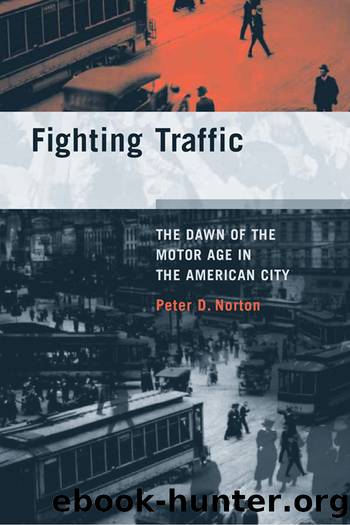Fighting Traffic: The Dawn of the Motor Age in the American City by Peter D. Norton;

Author:Peter D. Norton; [Norton, Peter]
Language: eng
Format: epub
ISBN: 9780262141000
Publisher: MIT Press
Published: 2008-04-18T00:00:00+00:00
Parking Meters
Parking meters later did the same for curb parking space. Free curb parking caused shortages, and shortages justified rationing (time limits) and outright bans. In 1935 Oklahoma City introduced parking meters. The idea originated in the city's Chamber of Commerce, which wanted to make the best use of limited space.132 Other cities followed this lead. Auto clubs feared that motoristsâ nickels, like gasoline taxes, might end up in general revenues.133 Most state and local auto clubs therefore resisted meters, and by 1936 the American Automobile Association coordinated this defensive âwar.ââ134 Meters spread slowly.135
But some auto clubs favored meters from the start. The Texas State Automobile Association regretted âanother form of taxation on the motorist,â but accepted meters because they âmake the âstreet hogâ put his car in the garage.ââ136 If meter revenues could be committed to street and parking expenses, they promised to make curb space an undisputed zone for motorists, just as gasoline taxesâonce they were committed to streets and highwaysâhelped give drivers proprietorsâ rights in the travel lanes. Meters increased parking supply by making time limits easier to enforce, by discouraging motorists who did not value the space they parked in, and by rewarding cities that returned no-parking curbs to parkers. By 1940 parking meters were becoming an accepted feature of city streets, and after World War II they proliferated.137
As soon as motorists were paying a substantial share of the bill for roads and curb space, automotive interest groups began to make a proprietary claim to them. Already in 1924 Public Works, a trade journal addressed to road builders (among others), argued that âautomobilists and other users of the highways are the ones to be satisfied,â since they âlargely provide the funds whereby the highways are constructed and maintained.â The traffic expert had no business determining and securing the public interest in transportation, rather âit is the duty of the engineer to determine what these and the other taxpayers want and to provide these wants to the fullest extent possible.â The journal asked readers to consider âhow large a percentage of the taxes are paid by automobile owners and, therefore, to what a very high degree the wishes of such owners should be consulted in the expenditure of taxes for constructing, reconstructing and maintaining streets and highways.ââ138 Traffic engineers such as Detroit's Harold Gould considered motoristsâ unregulated pursuit of their âpersonal whims or convenienceâ as the source of traffic problem, and proposed instead that âeconomicsââthat is, expert-determined standards of efficiencyââshould govern.ââ139 Motordom fully agreed that âeconomicsâ should guide urban traffic managementâ-yet they understood economics to include the individual demands (or âpersonal whimsâ) that traffic engineers deplored.
Download
This site does not store any files on its server. We only index and link to content provided by other sites. Please contact the content providers to delete copyright contents if any and email us, we'll remove relevant links or contents immediately.
| Buyers' Guides | Classic Cars |
| Customize | Driver's Education |
| Electric & Hybrid | Foreign |
| History | Industry |
| Insurance | Luxury |
| Motorcycles | Pictorial |
| Racing | Repair & Maintenance |
| Trucks & Vans |
Machine Learning at Scale with H2O by Gregory Keys | David Whiting(3572)
Never by Ken Follett(3513)
Urban Outlaw by Magnus Walker(3235)
OPNsense Beginner to Professional by Julio Cesar Bueno de Camargo(3189)
Sapiens and Homo Deus by Yuval Noah Harari(2838)
Will by Will Smith(2568)
A Short History of Nearly Everything by Bryson Bill(2503)
Hooked: A Dark, Contemporary Romance (Never After Series) by Emily McIntire(2407)
Rationality by Steven Pinker(2145)
Borders by unknow(2114)
Holy Bible (NIV) by Zondervan(2022)
The Becoming by Nora Roberts(1906)
The One Percenter Encyclopedia by Bill Hayes(1712)
Freedom by Sonny Barger(1710)
HBR's 10 Must Reads 2022 by Harvard Business Review(1693)
A Short History of War by Jeremy Black(1665)
Five Ways to Fall by K.A. Tucker(1629)
Girls Auto Clinic Glove Box Guide by Patrice Banks(1613)
Go Tell the Bees That I Am Gone by Diana Gabaldon(1592)
